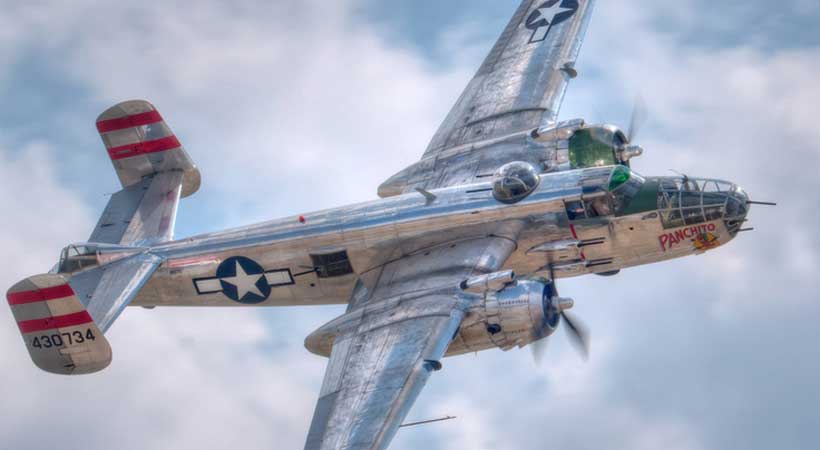
The B-25 Bomber was used by the U.S and its allies in every theater of World War II. The B-25 came to fame on April 18, 1942 during the Doolittle Raid. Lieutenant Colonel Jimmy Doolittle led 16 B-25s in a daring attack on mainland Japan, four months after the bombing of Pearl Harbor. Launched from the aircraft carrier Hornet, the raid was a one way mission as the aircraft could only launch and not land from its short deck.
The B-25J-25-NC SN 44-30734 now flying as “Panchito” was delivered on February 16, 1945. Accepted as surplus to military needs, she was initially stored in Garden City, Kansas before being transferred to South Plains, Texas. She was then moved to storage in Pyote, Texas in July of 1947. Her first assignment was to Vance Air Force Base, Oklahoma in November 1948. She spent four years at Vance as a pilot trainer before being assigned to James Connally Air Force Base, Texas in December of 1952. Here she was used for navigator and bombardier training. In August of 1954, she was transferred to the New York Air National Guard and stationed at Westchester county AFB. Here she was used by the 102nd Radar Calibration Flight to test and train airborne radar systems for the Air Defense Command fighters. Modified by Hayes and redesignated as a TB-25N in 1955, she was assigned to an Air Guard unit at Van Nuys, California for proficiency and type ratings until August 1958 when she was flown to storage.
The Original “Panchito”
25J, serial number 43-28147, was assigned to Captain Don Seiler of the 396th Bomb Squadron. Capt. Seiler named his new plane “Panchito” after the feisty Mexican rooster from the 1943 animated musical “The Three Caballeros”.
 Photo of the original ‘Panchito’ and her ground crew. |
The crew of the “Panchito” was composed of both combat veterans and recent trainee graduates. Pilot Capt. Don Seiler and bombardier Lt. Jud Driver, both seasoned combat veterans in their early twenties, were preparing for their second combat tour. Among the replacements making up the rest of the crew were copilot Lt. T. F. Shea, radio operator and gunner Corporal Norm Landry and an unusual pair of gunners, Corporals William and Robert Miller. Corporals William and Robert Miller were identical twins from Hummelston, Pennsylvania. Because the Army Air Forces policy which allowed them to be assigned together was so little known, they carried copies of the policy with them. Bill Miller was the flight engineer and top turret gunner while his brother, Bob, was tail gunner and armorer. Bill liked this arrangement since they could check on each other visually while on missions. On June, 1945, the 41st Bomb Group was reassigned, along with other Seventh Air Force bomber units, to Okinawa to participate in the aerial campaign leading up to the planned invasion of Kyushu in November 1945. Until other units were transferred from the Fifth Air Force later in July, the 41st continued to be the only B-25 unit in the Seventh Air Force. With the first mission against Chiran Airfield, Kyushu, Japan on July 1, 1945, the 41st became the first unit to attack the Japanese home islands with B-25’s since the Doolittle raid in 1942. Over the next month and a half, the 41st flew 48 combat or combat support missions against Japanese targets in Kyushu, the island chain north of Okinawa as well as Japanese bases in Eastern China. The targets of the 41st Bomb Group included Japanese airfields, shipping, and transportation and rail facilities. Panchito flew 19 of those missions including the last combat mission flown on August 12, 1945 against Kanoya Airfield, Kyushu. Announcement of the Japanese surrender caused the mission scheduled for August 13, 1945 to be cancelled. This mission was to include Panchito. Bill Miller retrieved the alert order for this mission from his unit’s bulletin board; an order that had been over-written as “CANCELLED”. He still has this document neatly folded in his old wartime diary.